The Question Mark Nebula is a young star forming nebula located approximately 2,900 light years away in the northern constellation Cepheus. It is listed as NGC 7822 in the New General Catalogue. The star forming complex includes the emission nebula Sharpless 171 (Sh2-171) and the young cluster of stars catalogued as Berkeley 59. The smaller and more distant Little Rosette Nebula (Sh2-170) marks the dot in the question mark.
NGC 7822 has an angular diameter of 3 degrees, corresponding to a physical size of around 150 light-years at its estimated distance. The nebula is streaked with several wisps of dark dust that are best seen in long-exposure photographs.
The Question Mark Nebula is a large stellar nursery full of young, exceptionally hot stars and young stellar objects. The intense ultraviolet radiation of the hottest stars in the region is heating up the nebular gas and making it produce its owl light. The young open cluster Berkeley 59 lies at the heart of NGC 7822. It is surrounded by the nebula Sh2-171.
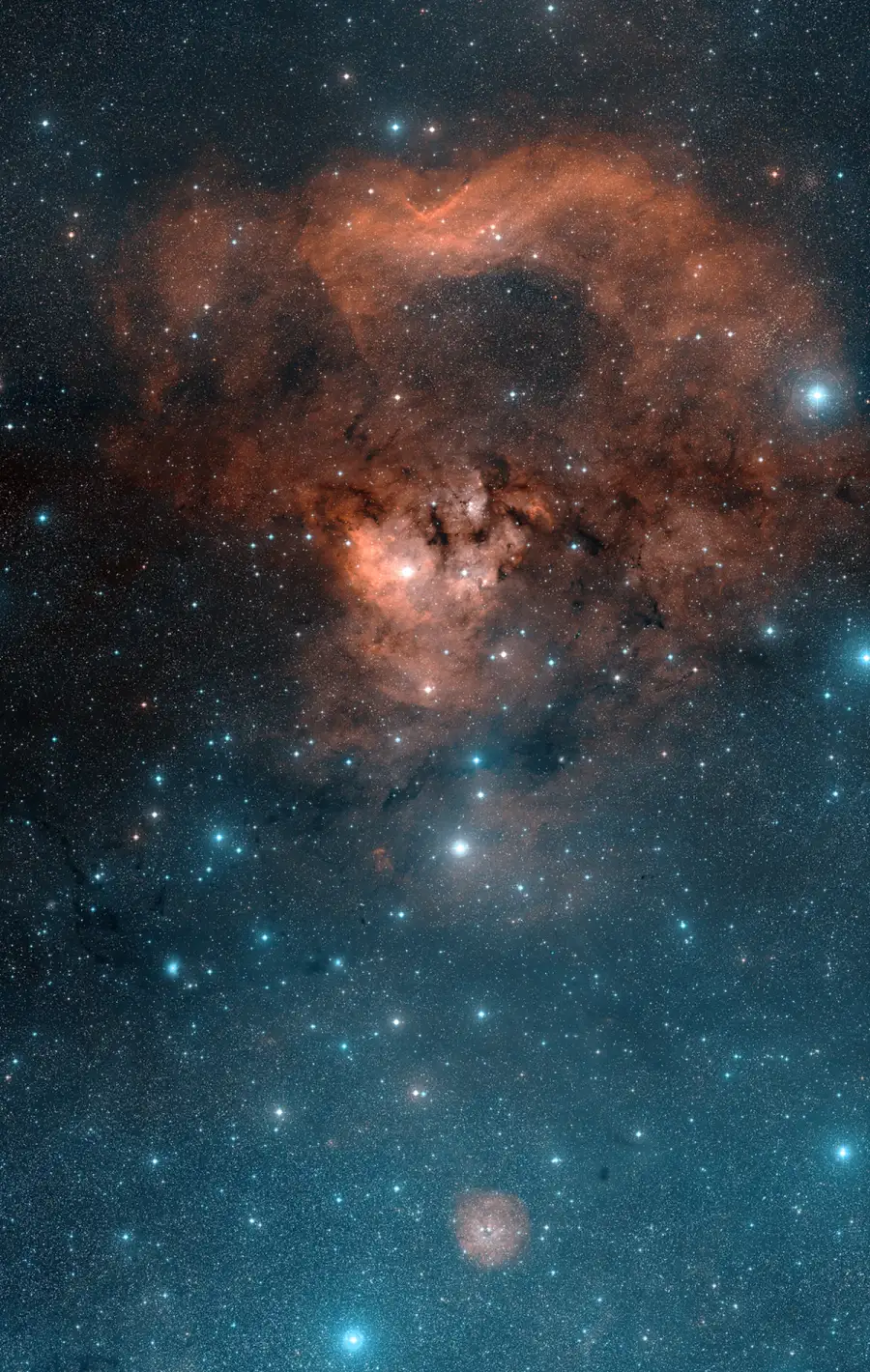
Question Mark Nebula (NGC 7822), image credit: Davide De Martin & the ESA/ESO/NASA Photoshop FITS Liberator (CC BY 3.0)
The young stars formed in the Question Mark Nebula are members of the Cepheus OB4 association, a young stellar association of massive O- and B-type stars with an estimated age of only 2 million years. The younger members of the group are only 1 million years old.
Berkeley 59
The open cluster Berkeley 59 is the central cluster of the Question Mark Nebula and of the Cepheus OB4 association. It contains several massive O- and B-type stars that are still surrounded by their natal molecular clouds. The cluster is home to young stellar objects (YSOs) – protostars and pre-main-sequence stars – that are still accreting mass from their parent clouds. These objects are still contracting to the main sequence and have not yet started burning hydrogen in their cores.
The young eclipsing binary system BD+66 1673 (V474 Cephei) contains a hot blue star of spectral type O5.5V(n)((f)), which is believed to be the main ionizing source for the surrounding nebula. The star system has an apparent magnitude of 10.07 and is invisible to the unaided eye. It appears at the northwestern edge of Berkeley 59.
BD+66 1673 has a surface temperature of almost 45,000 K a luminosity of 100,000 Suns. The star’s intense ultraviolet light excites the hydrogen gas in the nebula, making it glow. The hot star is also one of the primary sources responsible for carving the nebula’s gas clouds into pillars and elephant trunks.
In 2008, spectroscopic observations and photometry led astronomers to estimate a cluster age of around 2 million years and a distance of 883 ± 43 pc (2,880 ± 43 light-years).
More recent studies place the cluster at a greater distance. Kuhn et al. (2019) and Gahm et al. (2022) found a distance of 1,100 parsecs (3,588 ly), and Panwar et al. (2024) estimated a distance of 1.00 ± 0.06 pc (3,262 ± 196 ly).
Based on the parallax obtained in the Gaia Data Release 3 (Gaia DR3), the young cluster lies 1009 ± 12 parsecs (3,291 light-years) away and has a median age of 2.9 million years. At this distance, the cluster extends out to a radius of around 5 parsecs (16 ly).
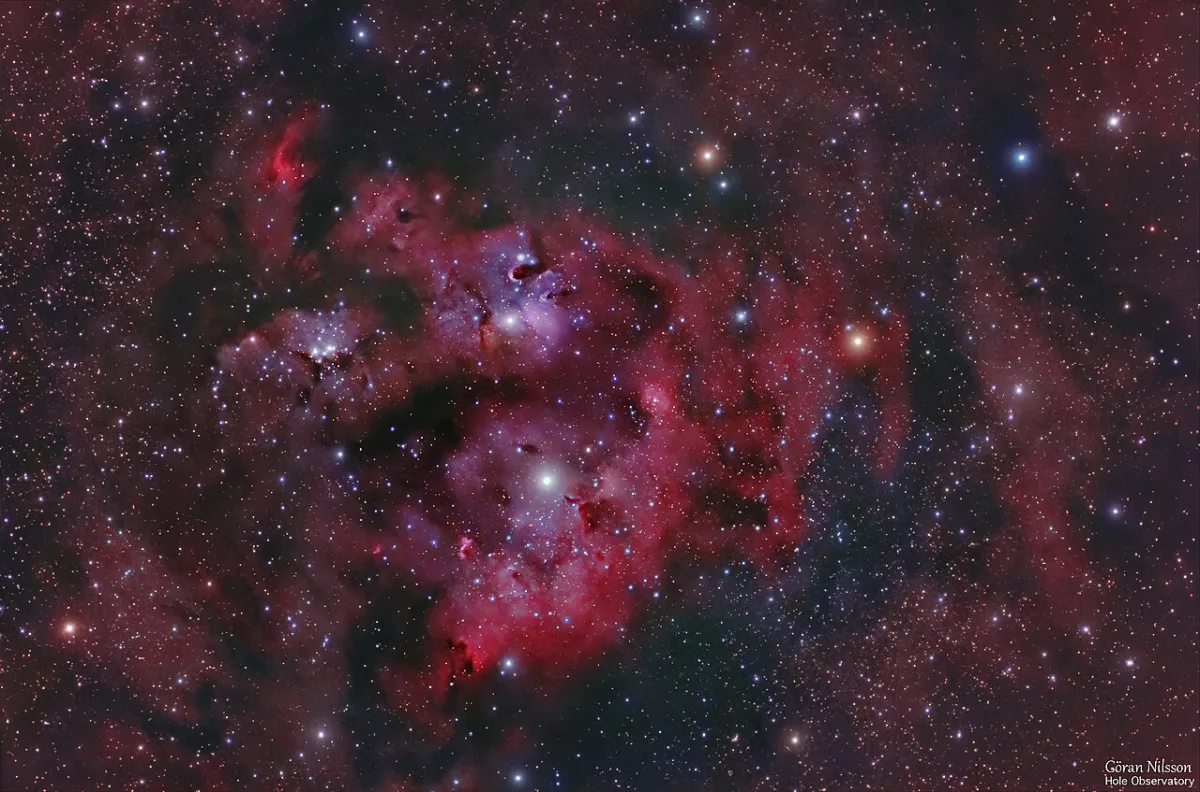
NGC 7822 – RGB image taken through a 5″ apo refractor (ES 127ED) with a Canon EOS 60Da camera (31 x 8 min exposures at ISO1600) on an EQ8 mount, image credit: Göran Nilsson, Hole Observatory (CC BY-SA 4.0)
Facts
NGC 7822 was discovered by the English astronomer John Herschel on November 16, 1829. Herschel observed the nebula with his 18.3-inch reflector and catalogued it as h 2302 (GC 5051), noting that it was “enormously large but extremely faint.” Danish astronomer John Louis Emil Dreyer added the nebula to his New General Catalogue as NGC 7822.
Swedish astronomer Sven Cederblad listed the southern part of the nebula as Cederblad 214 in his study of bright diffuse galactic nebulae, published in 1946. The southern portion of NGC 7822 is also catalogued as LBN 581 in the Lynds’ Catalogue of Bright Nebulae, compiled by the American astronomer Beverly Turner Lynds in the 1960s.
American astronomer Stewart Sharpless included NGC 7822 as Sharpless 2-171 in his catalogue of H II regions of 1959, noting an apparent diameter of 180 arcminutes (3 degrees). He identified the nebula as NGC 7822.
The Little Rosette Nebula (Sharpless 2-170), a smaller emission nebula in the neighbouring constellation Cassiopeia, forms the Question Mark Nebula (or the Cosmic Question Mark) with NGC 7822. The smaller and fainter nebula lies approximately 7,500 light years away, at a much greater distance than NGC 7822, and is not related to the emission region in Cepheus.
NGC 7822 was once suspected to contain a supernova remnant. However, observations in the late 1970s and early 1980s, combined with the overall morphology of the region, strongly indicated that there was no SNR in the nebula. The nebula was found to be an evolved H II region whose radio emission arose primarily from an optically thin thermal gas.
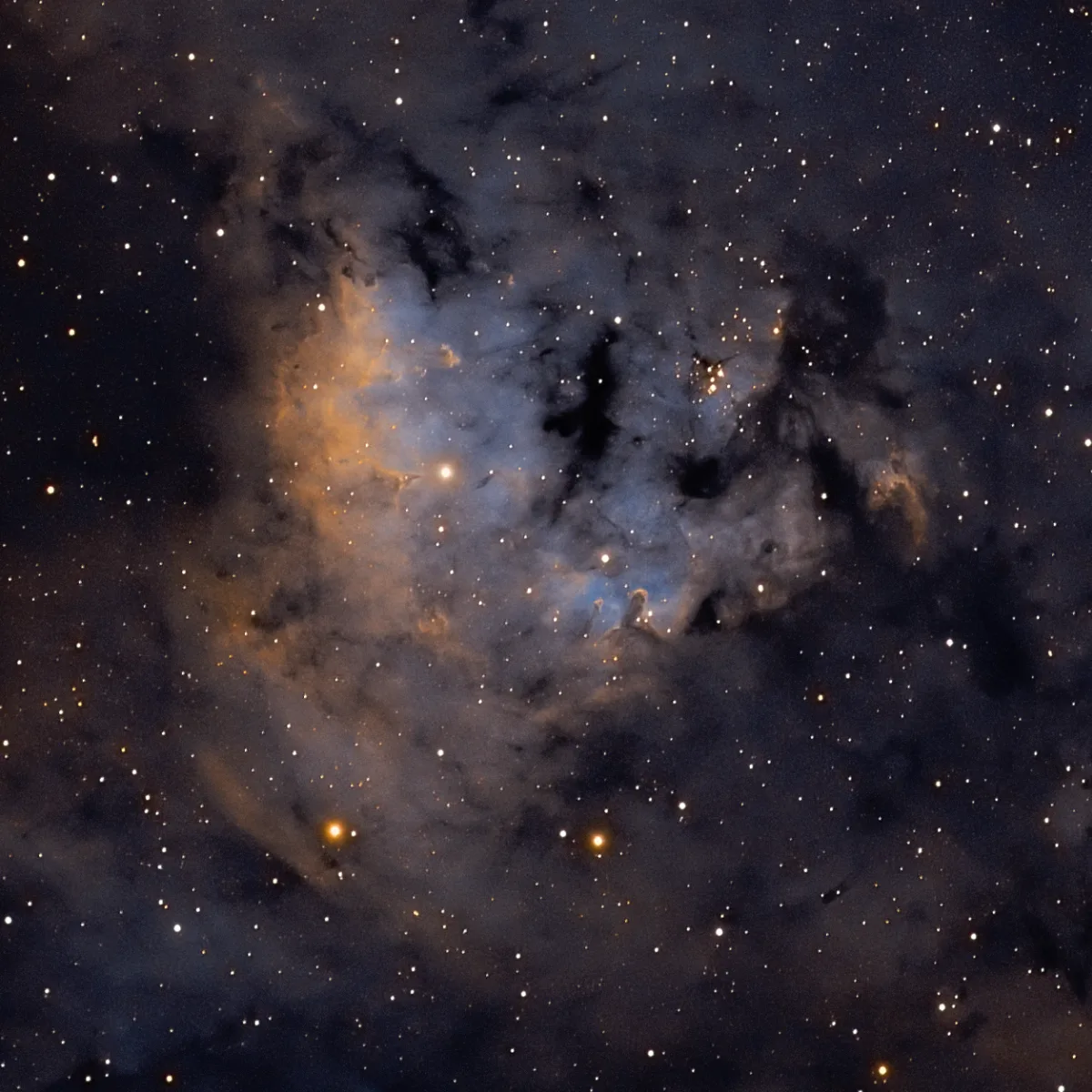
NGC 7822, image credit: Travis Hanna (CC BY-SA 4.0)
Location
NGC 7822 lies in the eastern part of Cepheus, in the region between two conspicuous asterisms, Cassiopeia’s W and the House of Cepheus. It appears about two thirds of the way from Segin (Epsilon Cassiopeiae), the leftmost star of the W, to Iota Cephei. The Little Rosette, the dot in the question mark, appears roughly halfway between Gamma Cassiopeiae and Iota Cephei.
The Question Mark Nebula lies in the far northern sky and is best seen and photographed from the northern hemisphere. At declination +67°, it never rises above the horizon for observers south of the latitudes 23° S.
The best time of the year to observe the Question Mark Nebula and other deep sky objects in Cepheus is during the month of November, when the constellation appears higher in the sky in the early evening.
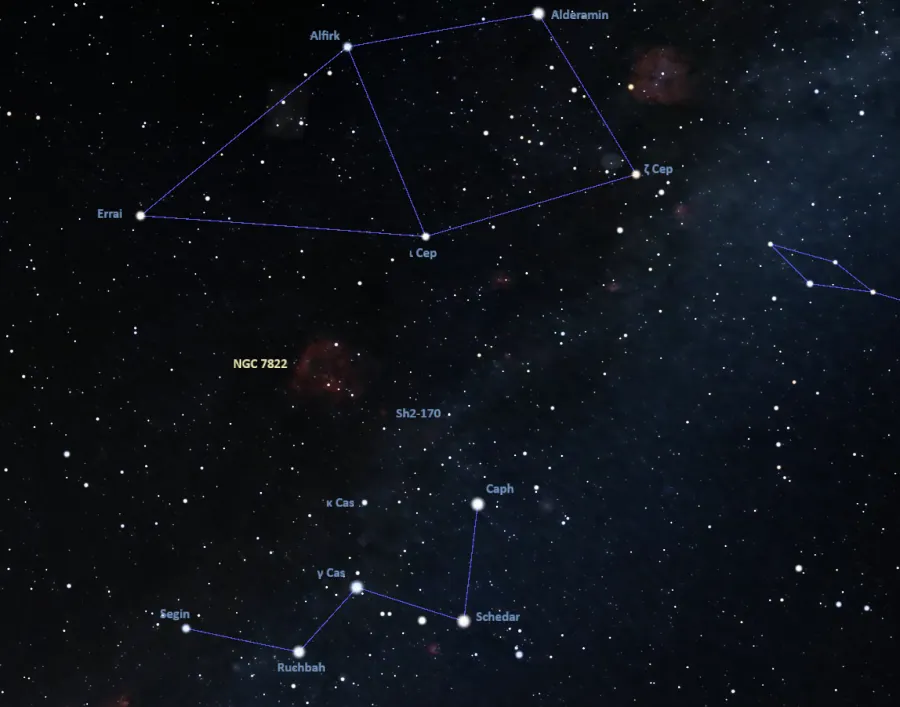
Question Mark Nebula location, image: Stellarium
Question Mark Nebula – NGC 7822
| Constellation | Cepheus |
| Object type | H II region |
| Right ascension | 00h 01m 08.58s |
| Declination | +67° 25′ 17.0″ |
| Apparent size | 3° |
| Distance | 2,900 light-years (900 parsecs) |
| Radius | 75 light-years (23 pc) |
| Names and designations | Question Mark Nebula, Cosmic Question Mark, NGC 7822, LBN 589, LBN 118.59+06.13, Sharpless 2-171, Sh2-171, CTB 2, GAL 118.15+04.96, SNR G118.3+04.8, [DGW65] 149, Cederblad 214A |
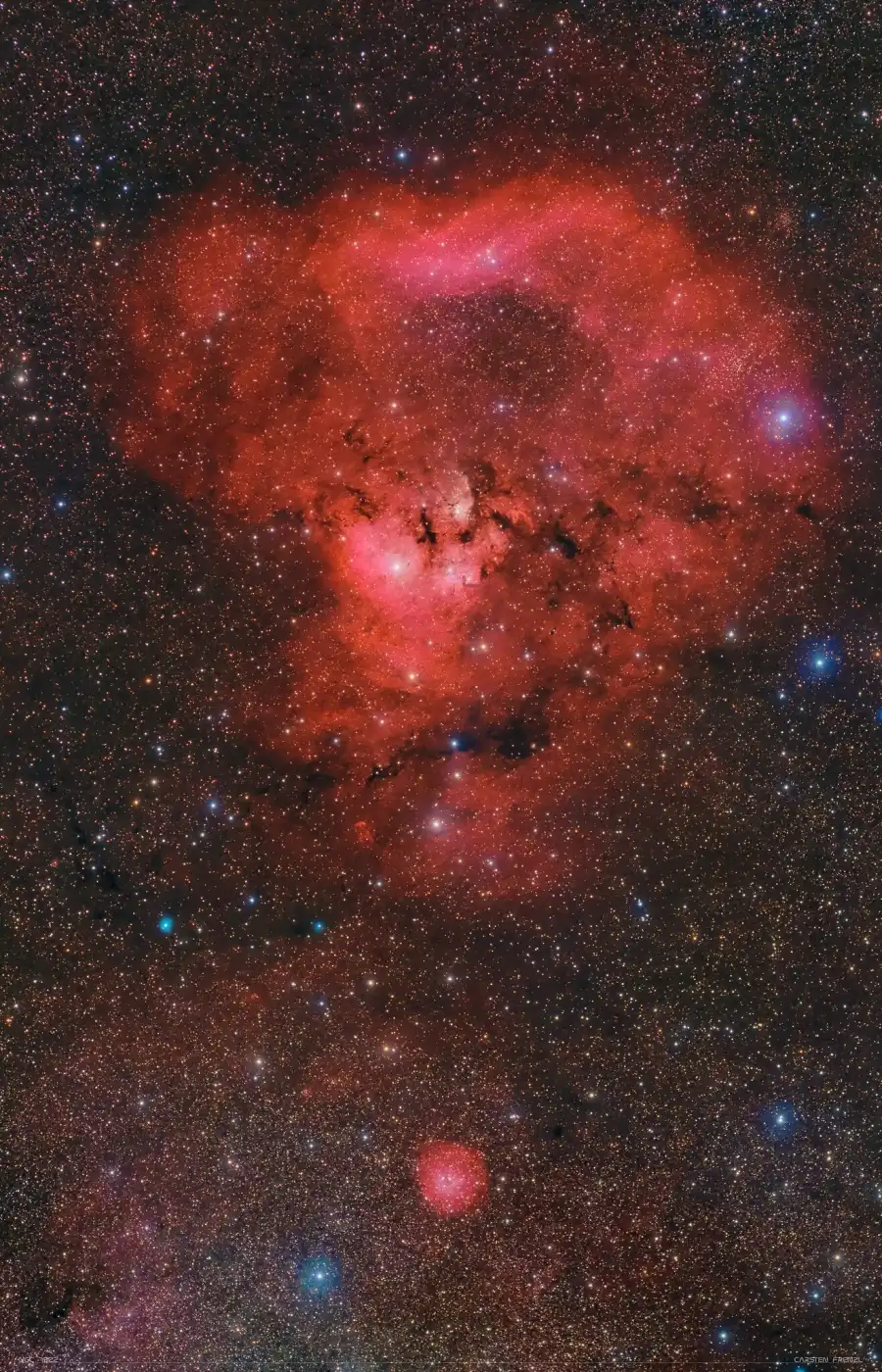
Question Mark Nebula (NGC 7822), image credit: Carsten Frenzl (CC BY 2.0)